Human leukocyte antigen class II-based immune risk model for recurrence evaluation in stage I-III small cell lung cancer
- PMID: 34362829
- PMCID: PMC8351500
- DOI: 10.1136/jitc-2021-002554
Human leukocyte antigen class II-based immune risk model for recurrence evaluation in stage I-III small cell lung cancer
Abstract
Background: Immunotherapy has revolutionized therapeutic patterns of small cell lung cancer (SCLC). Human leukocyte antigen class II (HLA class II) is related to antitumor immunity. However, the implications of HLA class II in SCLC remain incompletely understood.
Materials and methods: We investigated the expression patterns of HLA class II on tumor cells and tumor-infiltrating lymphocytes (TILs) by immunohistochemistry staining and its association with clinical parameters, immune markers, and recurrence-free survival (RFS) in 102 patients with stage I-III SCLC with radical surgery. Additionally, an HLA class II-based immune risk model was established by least absolute shrinkage and selection operator regression. With bioinformatics methods, we investigated HLA class II-related enrichment pathways and immune infiltration landscape in SCLC.
Results: HLA class II on tumor cells and TILs was positively expressed in 9 (8.8%) and 45 (44.1%) patients with SCLC, respectively. HLA class II on TILs was negatively associated with lymph node metastasis and positively correlated with programmed death-ligand 1 (PD-L1) on TILs (p<0.001) and multiple immune markers (CD3, CD4, CD8, FOXP3; p<0.001). Lymph node metastasis (OR 0.314, 95% CI 0.118 to 0.838, p=0.021) and PD-L1 on TILs (OR 3.233, 95% CI 1.051 to 9.95, p=0.041) were independent predictive factors of HLA class II on TILs. HLA class II positivity on TILs prompted a longer RFS (40.2 months, 95% CI 31.7 to 48.7 vs 28.8 months, 95% CI 21.4 to 36.3, p=0.014). HLA class II on TILs, PD-L1 on TILs, CD4, and FOXP3 were enrolled in the immune risk model, which categorized patients into high-risk and low-risk groups and had better power for predicting the recurrence than tumor stage. Pathway enrichment analyses showed that patients with high HLA class II expression demonstrated signatures of transmembrane transportation, channel activity, and neuroactive ligand-receptor interaction. High-risk SCLC patients had a higher proportion of T follicular helper cells (p=0.034) and a lower proportion of activated memory CD4-positive T cells (p=0.040) and resting dendritic cells (p=0.045) versus low-risk patients.
Conclusions: HLA class II plays a crucial role in tumor immune microenvironment and recurrence prediction. This work demonstrates the prognostic and clinical values of HLA class II in patients with SCLC.
Keywords: antigen presentation; immunohistochemistry; lung neoplasms; lymphocytes; tumor microenvironment; tumor-infiltrating.
© Author(s) (or their employer(s)) 2021. Re-use permitted under CC BY. Published by BMJ.
Conflict of interest statement
Competing interests: None declared.
Figures




References
Publication types
MeSH terms
Substances
LinkOut - more resources
Full Text Sources
Medical
Research Materials
